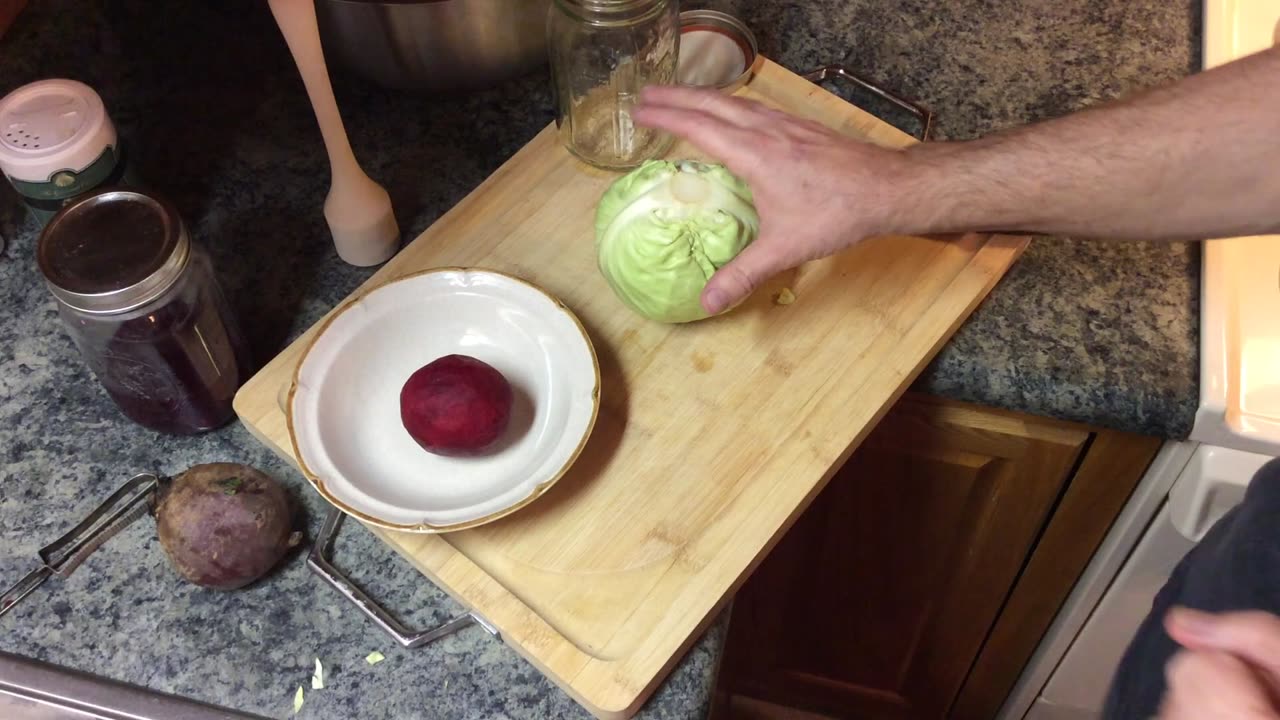Premium Only Content

Make Homemade Cabbage And Beet Sauerkraut - Organic
Welcome, sports fans! I've been meaning to share this forever. Many people have been curious about it, so today, I'm talking about homemade kraut — specifically, homemade organic cabbage and beet sauerkraut. It's the best kind, and I use it in my diet every day. Sauerkraut is great for your gut health, helps you digest your food better, and allows you to absorb vitamins and minerals more efficiently. Studies even suggest that a healthy gut can make you smarter, improve your immune system, and combat infections more effectively. There's virtually no downside and all kinds of upsides to adding sauerkraut to your daily diet!
One of the things I want to caution you about is the type of salt you use. This is the easiest food you'll ever prepare other than boiling water, but it's vital to use the correct salt. Always opt for sea salt. Avoid table salt, iodized salt, and even kosher salt. These contain talc, alum, ferrous cyanide, and silica, which are bad for you and can mess up the fermentation process. This method is called lacto-fermentation, and although it might seem daunting at first, it's actually straightforward.
For today's recipe, I'll be using a combination of cabbage and beets. Beets are excellent because they help produce nitric oxide, which has been shown to improve brain function and memory. In fact, the Nobel Prize in 1998 was awarded for research related to this. Whenever possible, use organic produce or get your vegetables from sources you trust, like local farmers who don't use herbicides or pesticides. I'll start by peeling an organic beet with an old peeler, which works great despite its age. The process is simple and won't take more than a few minutes.
First, cut the cabbage in half and remove the core. I prefer my cabbage pieces to be fairly large, but you can chop them to your liking. Once you've chopped the cabbage, place it in a stainless steel or crockware bowl. Avoid using aluminum or plastic bowls, as these can contaminate the mixture. Next, carefully chop the beets. Beets can stain your hands and surfaces, so handle them with care. After chopping, add the beets to the bowl with the cabbage. For each head of cabbage and one beetroot, I usually add about a tablespoon of sea salt. Mix everything well, and you'll notice the cabbage starting to release moisture.
Transfer the mixture into a one-quart mason jar. Use a tool like a smasher to press down the mixture and remove air pockets. This will also help extract more moisture from the vegetables. Continue to press and pack the jar until it's full. If you have filtered, distilled, or well water (without chlorine), you can add it to the jar to cover the vegetables. Make sure everything is tightly packed and that the salt is well distributed.
Now, let the jar sit at room temperature for about three to four days to start the fermentation process. You can also refrigerate it if you're worried about it going bad, but this will slow down the fermentation. Sometimes, a bit of mold might form on top; just skim it off. If you have some leftover sauerkraut from a previous batch, you can add it to the new batch to speed up the fermentation. Within a few days, you'll have delicious, tangy cabbage and beet sauerkraut ready to enjoy.
And that's all there is to it, sports fans! Homemade sauerkraut is easy to make and incredibly beneficial for your health. I hope you enjoyed this tutorial, and if you have any questions, feel free to reach out. Enjoy your kraut-making journey!
-
 7:31
7:31
The Longer Crowbar
2 months agoRFK Jr. on America's Devolution and the Fight for Freedom
47 -
 LIVE
LIVE
Glenn Greenwald
3 hours agoDC Attacks Trump's Most Disruptive Picks; Biden Authorizes Massive Escalation With Russia; Joe & Mika Meet With "Hitler" | SYSTEM UPDATE #367
6,544 watching -
 LIVE
LIVE
The Jimmy Dore Show
2 hours agoBiden To Let Ukraine Fire Missiles Deep Into Russia! Kamala Campaign’s WILD Spending! w/Scott Ritter
12,578 watching -
 1:44:34
1:44:34
Tucker Carlson
2 hours agoTucker Carlson and Russ Vought Break Down DOGE and All of Trump’s Cabinet Picks So Far
70.2K114 -
 2:05:14
2:05:14
Robert Gouveia
4 hours agoFBI Criminals Get LAWYERS; STOP Counting ILLEGAL Votes; Time to Disbar Tish James
12.7K35 -
 LIVE
LIVE
The StoneZONE with Roger Stone
2 hours agoAre We Heading For World War III? General Michael Flynn Joins The StoneZONE w/ Roger Stone
985 watching -
 LIVE
LIVE
Tundra Gaming Live
4 hours agoThe Worlds Okayest War Thunder Stream
409 watching -
 1:20:47
1:20:47
Donald Trump Jr.
6 hours agoThe MAGA Cultural Shift, Plus UFC at MSG & Interview with Newt Gingrich | TRIGGERED Ep.192
103K87 -
 45:18
45:18
Kimberly Guilfoyle
6 hours agoBreaking News on Latest Cabinet Picks, Media Spins in Circles,Live with Tim Hentschel & Alex Epstein | Ep. 175
86.9K27 -
 1:45:00
1:45:00
Redacted News
5 hours agoBREAKING! TRUMP TO DECLARE NATIONAL EMERGENCY DECLARATION DEPLOY MILITARY TO SOUTHERN BORDER
139K401